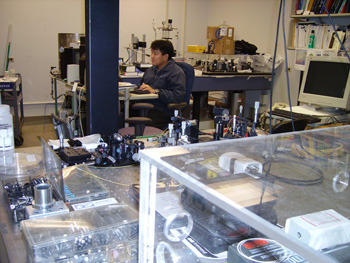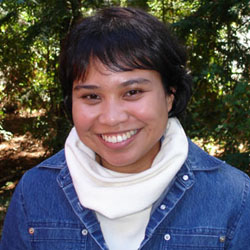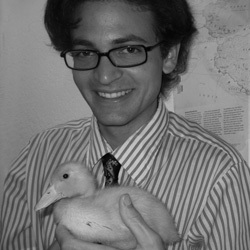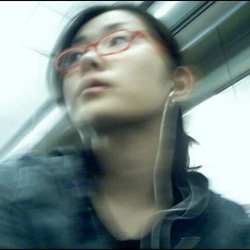Small Things Considered
Hyuck Choo is a master of microscale mechanics and miniature movable mirrors. Massie Santos Ballon takes a close look at the man and his plans. Illustrated by Joe Sharkey and Koko Takatori.

Illustration: Joe Sharkey
Hyuck Choo’s second home is a workshop simply known as Room 173. It’s behind the door marked “Optoelectronics Lab” on the first floor of Cory Hall, home to the electrical engineers and computer scientists at UC Berkeley.
The boyish postdoctoral researcher often thought about connecting the workshop to his actual home. “If I could just walk into the lab from the bedroom, that would be OK,” he says.
To say Choo used to live in Cory Hall isn’t much of an exaggeration. During the early years of his graduate studies in electrical engineering, Choo would spend 18-hour days in the building. He divided his time between Room 173, where he designed and tested microscale devices, and the MicroFabrication Laboratory on the fourth floor. There, he made microelectromechanical system devices, or MEMS—including some blazingly fast "microscanners" that could form the heart of an ingenious pocket-sized projector.
A microscanner is a tiny machine with a movable mirror that directs laser beams. People have made these devices for nearly 40 years. Anyone who’s seen the brief flash of light when a cashier scans an item’s bar code at the checkout counter has seen one in action. And anyone who’s used a laser printer or laser copier can thank microscanners for getting the job done.
Choo, 36, likes to sweat the small stuff. He and his colleague David Garmire, a computer scientist, patented a simple and low-cost technique to make microscanners. They're not the world's smallest, Choo says, but they're "the best ever." About 90% of the devices work, an unheard-of rate for a university lab. Scaling the assembly up to a commercial process could pay off handsomely for the duo.
A life of tiny motors
“I heard about micromachines when I was an undergraduate,” Choo says. “I could make, actuate, and control tiny little parts that were even smaller than my hair, and they could still perform useful functions. In some sense, MEMS is the fusion of advanced science and my childhood toys.”
 |
Photo: Massie Santos Ballon |
| Engineer Hyuck Choo works in the optoelectronics lab at UC Berkeley. |
|
|
Under a shock of black hair, Choo's eyes sparkle as he traces his interest in tiny motorized devices back to his childhood in South Korea. Lego Technic sets that let kids build moving things out of blocks, gears, and wheels were too expensive for the average household there, but Choo remembers building and playing with remote-control models of tanks and buggies. “Koreans must have toys that are motorized,” he says.
After moving to America during his teens, Choo entered the engineering program at Cornell University. There, he encountered a textbook that changed his life and brought him to Berkeley.
From his bookshelf, Choo pulls out the dark blue text. Device Electronics for Integrated Circuits, 2nd edition, doesn’t seem like a compelling read, but the researcher says he often pored over the chapters until the wee hours. The book introduced him to MEMS technology, he says. When one of his Cornell professors mentioned that the book’s author, Richard S. Muller, still had a lab at UC Berkeley, Choo applied to join it.
Muller, founding director of the Berkeley Sensor & Actuator Center, says Choo brought in new ideas for the microscanner project his lab had been working on for several years. “He has a very searching mind,” says Muller, who is retired. “The idea crystallizes and takes shape, even as he’s describing it.”
Choo has a knack for keeping it simple, adds former UC Berkeley collaborator Rishi Kant. “The simplicity of Hyuck’s solutions makes them easily realizable,” says Kant, now a graduate student at Stanford. Like so much of engineering, MEMS boils down to problem solving— that, he says, is Choo's forté.
A man, a plan, a partnership
Over spring break, David Garmire returns from his new faculty position at the University of Hawaii, Manoa, to catch up on projects with Choo. During a pizza lunch—complete with Hawaiian slices—they recall how their partnership began.
Garmire met Choo while working in a lab next to Room 173. Frequent hallway encounters led them to collaborate. When Choo came up with the idea of working on microscanners, the “computer wizard” Garmire was the person he approached. Choo brought the manufacturing savvy, while Garmire excelled at software and testing.
“I wouldn’t have pursued it without David,” Choo says. “If you just demo the microscanner fabrication, the work only has half the value. The fabrication and device testing—that was possible because we worked together.”
“I’ve found Hyuck to be more than an engineer,” Garmire says in response. “He is someone who cares strongly for his family and community, has a deep understanding of history, and is a great friend.”
Garmire, 29, looks like a curly-haired blond teenager next to the stocky Choo. His interest in computer science started as a kindergartener playing with his father’s calculator. By high school, he was writing code and programming in a number of computer languages. “My heart was set,” he says. “I was fascinated by the fact that you could recreate physics on a computer and predict what happens in the real world from the simulated world.”
The two researchers have big plans for their microscanners. Their business plans for making the microscanners won awards at various competitions. Now they’re working on bringing the key element to fruition: producing laser modules for pocket-sized projectors.
It's a long journey that starts in Room 173. For the benefit of a visitor, Choo agrees to simulate the entire fabrication process. He starts at his computer, clicking on file icons around desktop images of his son, to pull up diagrams of a microscanner. They're rectangular schematics in various colors, each corresponding to a layer on the device. On the screen they loom large and garish, but the finished product will be smaller than a square centimeter.
 |
Photo: Courtesy of Hyuck Choo |
The tiny mirror in this microscanner, made at the UC Berkeley MicroLab, pivots thousands of times each second. |
|
|
Lines and curves indicate the locations of the tiny mirror. Rows of bars depict miniature combs that allow the mirror to pivot back and forth, directing the laser’s movements in precise patterns. Two sets of combs with overlapping teeth bracket a thin band that centers the mirror. Electrical impulses drive the comb attached to the band; the other comb is fixed in place.
The diagrams dictate the fabrication process, in which the device's layers are etched with chrome onto three thick quartz glass plates called photolithography masks. These masks will transfer the designs onto silicon wafers to make the microscanners in the magical workshop where Choo says all the grown-up toys are made: the campus MicroLab.
Going through the motions
The key to using the MicroLab is preparation. Every minute inside costs 50 cents, and that quickly adds up during the time-consuming work. Choo admits that he learned to come in with a plan “after a few time-and-money-consuming blunders” during the first year he used the facility.
To run through a mockup of the microscanner fabrication process, Choo first needs to dress for entry. The MicroLab is a Class 100 cleanroom, meaning there shouldn’t be more than 100 particles greater than 0.5 microns in size within each cubic foot of air. In comparison, a human hair is a whopping 100 microns thick. Every time Choo moves, he sheds particles. So to enter the MicroLab, he must don a blue shower cap, safety glasses, gloves, white Tyvek coveralls, blue shoe covers, and white Uggs-like Tyvek boots.
It takes Choo less than a minute to gown up except for the gloves and boots. “I’ve had practice,” he says simply.
He steps around a bench that separates the “dirty” and “clean” gowning zones and onto a sticky mat before covering his hands and feet. It’s a short walk from there to the lab, where Choo opens the door. A persistent buzz of white noise instantly bombards the senses. In the first step of his simulated demonstration, Choo “bakes” a layer of photoresistant liquid onto a silver, four-inch-wide silicon wafer. Disc in hand, he crosses a corridor to a machine that will imprint each photomask’s design onto the wafer. With the first design down, he heads to a room housing the silicon etcher. In a four-hour process, the machine would etch the areas on the silicon wafers that are not covered by the photoresist-imprinted pattern. Then, a machine resembling an ancient dot matrix printer would verify that the desired etching depth was achieved.
Choo would repeat the imprinting and etching process twice more on the front and back of the silicon wafer. A single 4-inch wafer could yield 116 microscanners, neatly arrayed across the face of the disc. After all this work, the etched squares of mirrors and combs are barely visible, almost looking like outlines rather than three-dimensional objects. They sit just 50 microns above the wafer’s surface.
To cut them out, Choo walks through wooden doors to a small room with a dicing machine. Here the buzzing noise pervading the MicroLab gives way to a high-pitched hum, reminiscent of sci-fi shows from the 1960s. The wafer goes under the microscope, its image enlarged on the TV screen above. Crosshairs on the display allow Choo to line up the wafer's image with the boundaries of its intended design before he makes any cuts.
With the cut microscanners temporarily bonded onto a blank wafer for easy portability, it’s time for a fourth and final run through the silicon etcher to free the movable combs that will allow the mirror to twist. An acid bath removes the finished scanners from the wafer; one final machine blasts carbon dioxide gas to dry the devices.
In Choo's whirlwind walkthrough of the MicroLab, this all took an hour. Doing it for real, though, takes two weeks. “And that’s short,” Choo notes. Current commercial applications can take up to six months to make microscanners, he says, drastically increasing the production costs.
At this point, Choo would hand the finished microscanners off to Garmire for testing. When assembled, the Lego-like pieces of circuitry are about an inch long, with the mirrors nestled at their centers. Testing them involves connecting both the microscanners and a tiny laser beam to a computer program that Garmire wrote. Making accurate measurements with such small structures, he notes, is tricky.
First, Garmire verifies that each microscanner’s mirror resonates at the desired frequency. By changing the voltage that goes through the attached combs, he can change the speed at which the mirror swivels. It's generally faster than the eye can see: Choo has a video showing a mirror pivoting 7,800 times per second. Some of their scanners are designed to move three times faster than that.
To check on the accuracy of these micromovements, Garmire sends a burst of laser light to the tiny device and then measures how much of the light gets deflected by the mirror. He refines and adjusts the angles as needed to ensure that the laser targets the right area of the mirror every time. When everything works smoothly, the mirrors can steer laser light, allowing them to scan surfaces rapidly, form any pattern desired for use in applications such as refractive eye surgery (see sidebar) and even project moving pictures.
The efficiency of the team's process, start to finish, has impressed outside observers. “Yields of 70 to 90% are very high for a university lab,” says Olav Solgaard, an electrical engineer at Stanford. “Those numbers mean that commercialization might be easier and more profitable than for many earlier MEMS structures that are difficult to make in a commercial foundry.”
Green will mean go
Choo and Garmire want to mass-produce modules that contain their microscanners, laser light sources, and electronics to control the lasers for a low-cost portable projector. It would be a true pocket device, the size of a cell phone, rather than the tabletop projectors now in vogue in most classrooms and boardrooms. But the technology still faces a few barriers.
Notably, the modules must contain three colored lasers—blue, red, and green—to combine their images into full color for our eyes. “Think of having 3 laser points sweeping across a screen really, really fast,” Garmire says. To handle these bursts of color, each module would contain up to six independently controlled microscanners—two mirrors per laser.
However, only the red and blue lasers are now available in semiconductor LED diode forms. Choo seems willing to wait a couple of years for companies to develop a green laser diode. “When I was an undergrad,” he says, “the blue laser diode was just a dream. Now it has a lifetime of 10,000 hours.”
In the meantime, Choo still plans to work on other MEMS projects in Room 173. But he has a new and even more exacting pursuit now: He has joined a nanotechnology lab at Lawrence Berkeley National Laboratory's Molecular Foundry, just up the hill from UC Berkeley. There, he'll set his sights on creations 1000 times smaller than the microscanners that consumed so many of his years.
Choo won't be bringing his work home though. The 9-to-5 man has a different kind of miniature project—his three-and-a-half-year-old son—waiting for him there with plans of his own. Soon there will be two voices bossing the researcher around; another child is on the way.
“He specifically tells me what to do,” Choo grins. “We play pirates, ride bikes, or play with his toys. He has Legos!” From the gleam in Choo's eyes, it’s not clear who enjoys the plastic bricks more.
Top
Sidebar: The Light in Your Eyes
As graduate students at UC Berkeley, Hyuck Choo and David Garmire thought their optical microscanners were ideally suited for refractive eye surgery. They demonstrated a system that Garmire describes “as good as the state of the art.”
The challenge is steep: A microscanner used in surgery must be so accurate and stable that it slices exactly the right tissues, every time. “We don’t want to blind somebody,” Garmire observes.
“Laser control is crucial,” agrees Dr. Danny Lin, a surgeon with the Pacific Eye Associates in San Francisco who works with two different types of laser systems. “The location, depth, power, and proximity of the laser applications need to be exact.”
Dr. Todd Severin, medical director of the Pacific Laser Eye Center Medical Group and a surgeon at UC Berkeley’s Refractive Surgery Center, concurs that keeping the laser on target is tricky. “What you’re trying to compensate for are the little psychotic movements,” he says. “A lot of patients vibrate. When you’re working within a 6.5-millimeter zone, one millimeter is a huge movement.”
Garmire says their microscanners deal with such eye movements by moving “faster than the eye can.” Monitoring the patient’s eye movements allows the surgeons to time the laser pulses that ablate the eye’s surface. Feedback systems keep the mirrors oscillating at stable speeds. “This reduces the possibilities of errors occurring during surgery and shortens the amount of time a patient must wait for the eye surgery to be complete,” Garmire says.
As the researchers pursued popular applications for their microscanner patent, Garmire and Choo shifted their focus to developing pocket-sized projectors. However, they haven’t forgotten the promise of the original eye surgery proposal. “We think people will find both applications highly useful and beneficial,” Choo says.
Top
Biographies
Massie Santos Ballon
B.A. (molecular biology and biochemistry)
Wesleyan University
Internship: 23andMe (Mountain View, CA)
“What are you doing next?” was the question from my biology professor. Most of my lab colleagues looked ahead to graduate school or medical school, but I talked about teaching English literature to Filipino college students. My professor's shock mirrored the reaction three years earlier of my high-school English teacher, who was amazed to learn I was a science major.
But for me, creative writing always complemented the hands-on lab work. Science was more fun when I could write and talk about research outside of my dry lecture courses. I’ve tried to share that delight as a science columnist, technical writer, textbook coauthor, and even in a literary contest. Although many people think understanding science is as intimidating as appreciating poetry, I’m working on proving them wrong.
. . . . . . . . . . . . . . . . . . . . . . . . . . . . . . . . . . . . . . . . . . . . . . . . . . . 
Joseph C. Sharkey
B.A. (Visual Arts), University of San Francisco
I have been drawing and flipping rocks in search of creepy-crawlies since my earliest days in San José. Hoping to better the world through visual communication, I studied graphic design, education and variety of visual media in San Francisco. I am intrigued by the educational potential of the synthesis of art and science, as both are excellent methods through which we can learn about our world and ourselves. The challenge of focusing my artistic process toward scientific communication has been truly thrilling. I hope to use my training in science illustration to educate people about the wonders of the natural world, inform about issues of environmental justice, and help make science accessible to everyone. My scientific interests are evolution, botany, herpetology, ecology and climate change. I will soon be completing illustrations for a natural history guide to Mojave Desert birds.
. . . . . . . . . . . . . . . . . . . . . . . . . . . . . . . . . . . . . . . . . . . . . . . . . . .
 Koko Takatori Koko Takatori
B.A. (psychology, pre-medicine) Wellesley College
I was born in Tokyo, Japan, where I attended international schools. My high school AP art course was where I realized my passion for visualization. I graduated from Wellesley College in 2007, where I took core science courses as a pre-med. Unable to let go of my passion, I entered the Science Illustration Program, which fused the two fields of study that I love. Currently, I am interning at a 3D medical animation studio in New York City.
Top
|

